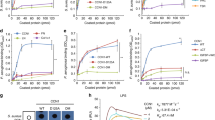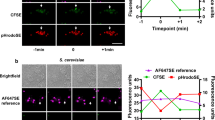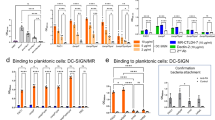Abstract
Microbial pathogens use a variety of their surface molecules to bind to host extracellular matrix (ECM) components to establish an effective infection. However, ECM components can also serve as an integral part of the innate immunity. Mice lacking expression of mindin (spondin 2), a highly conserved ECM protein, have an impaired ability to clear bacterial infection, and mindin-deficient macrophages show defective responses to a broad spectrum of microbial stimuli. Moreover, mindin binds directly to bacteria and their components and functions as an opsonin for macrophage phagocytosis of bacteria. Thus, mindin is essential in the initiation of the innate immune response and represents a unique pattern-recognition molecule in the ECM for microbial pathogens.
This is a preview of subscription content, access via your institution
Access options
Subscribe to this journal
Receive 12 print issues and online access
$209.00 per year
only $17.42 per issue
Buy this article
- Purchase on Springer Link
- Instant access to full article PDF
Prices may be subject to local taxes which are calculated during checkout







Similar content being viewed by others
Accession codes
References
Janeway, C.A. Jr. & Medzhitov, R. Innate immune recognition. Annu. Rev. Immunol. 20, 197–216 (2002).
Hoffmann, J.A., Kafatos, F.C., Janeway, C.A. & Ezekowitz, R.A. Phylogenetic perspectives in innate immunity. Science 284, 1313–1318 (1999).
Fraser, I.P., Koziel, H. & Ezekowitz, R.A. The serum mannose-binding protein and the macrophage mannose receptor are pattern recognition molecules that link innate and adaptive immunity. Semin. Immunol. 10, 363–372 (1998).
Crouch, E. & Wright, J.R. Surfactant proteins a and d and pulmonary host defense. Annu. Rev. Physiol. 63, 521–554 (2001).
Medzhitov, R. Toll-like receptors and innate immunity. Nat. Rev. Immunol. 1, 135–145 (2001).
Aderem, A. & Ulevitch, R.J. Toll-like receptors in the induction of the innate immune response. Nature 406, 782–787 (2000).
Takeuchi, O. et al. Differential roles of TLR2 and TLR4 in recognition of gram-negative and gram-positive bacterial cell wall components. Immunity 11, 443–451 (1999).
Poltorak, A. et al. Defective LPS signaling in C3H/HeJ and C57BL/10ScCr mice: mutations in Tlr4 gene. Science 282, 2085–2088 (1998).
Hoshino, K. et al. Cutting edge: Toll-like receptor 4 (TLR4)-deficient mice are hyporesponsive to lipopolysaccharide: evidence for TLR4 as the Lps gene product. J. Immunol. 162, 3749–3752 (1999).
Qureshi, S.T. et al. Endotoxin-tolerant mice have mutations in Toll-like receptor 4 (Tlr4). J. Exp. Med. 189, 615–625 (1999).
Alexopoulou, L., Holt, A.C., Medzhitov, R. & Flavell, R.A. Recognition of double-stranded RNA and activation of NF-kB by Toll-like receptor 3. Nature 413, 732–738 (2001).
Hayashi, F. et al. The innate immune response to bacterial flagellin is mediated by Toll-like receptor 5. Nature 410, 1099–1103 (2001).
Takeuchi, O. et al. Discrimination of bacterial lipoproteins by Toll-like receptor 6. Int. Immunol. 13, 933–940 (2001).
Hemmi, H. et al. A Toll-like receptor recognizes bacterial DNA. Nature 408, 740–745 (2000).
Hay, E.D. (ed.). Cell Biology of Extracellular Matrix. 2nd edn. 1–468 (Plenum, New York, 1991).
Patti, J.M., Allen, B., McGavin, M.J. & Hook, M. MSCRAMM-mediated adherence of microorganisms to host tissues. Annu. Rev. Microbiol. 48, 585–617 (1994).
Westerlund, B. & Korhonen, T.K. Bacterial proteins binding to the mammalian extracellular matrix. Mol. Microbiol. 9, 687–694 (1993).
Okamura, Y. et al. The extra domain A of fibronectin activates Toll-like receptor 4. J. Biol. Chem. 276, 10229–10233 (2001).
Klar, A., Baldassare, M. & Jessell, T.M. F-spondin: a gene expressed at high levels in the floor plate encodes a secreted protein that promotes neural cell adhesion and neurite extension. Cell 69, 95–110 (1992).
Feinstein, Y. et al. F-spondin and mindin: two structurally and functionally related genes expressed in the hippocampus that promote outgrowth of embryonic hippocampal neurons. Development 126, 3637–3648 (1999).
Higashijima, S., Nose, A., Eguchi, G., Hotta, Y. & Okamoto, H. Mindin/F-spondin family: novel ECM proteins expressed in the zebrafish embryonic axis. Dev. Biol. 192, 211–227 (1997).
Umemiya, T., Takeichi, M. & Nose, A. M-spondin, a novel ECM protein highly homologous to vertebrate F-spondin, is localized at the muscle attachment sites in the Drosophila embryo. Dev. Biol. 186, 165–176 (1997).
Manda, R. et al. Identification of genes (SPON2 and C20orf2) differentially expressed between cancerous and noncancerous lung cells by mRNA differential display. Genomics 61, 5–14 (1999).
Adams, J.C. & Tucker, R.P. The thrombospondin type 1 repeat (TSR) superfamily: diverse proteins with related roles in neuronal development. Dev. Dyn. 218, 280–299 (2000).
Morrison, D.C. & Ryan, J.L. Endotoxins and disease mechanisms. Annu. Rev. Med. 38, 417–432 (1987).
Raetz, C.R. & Whitfield, C. Lipopolysaccharide endotoxins. Annu. Rev. Biochem. 71, 635–700 (2002).
Galli, S.J., Maurer, M. & Lantz, C.S. Mast cells as sentinels of innate immunity. Curr. Opin. Immunol. 11, 53–59 (1999).
Malaviya, R. & Abraham, S.N. Mast cell modulation of immune responses to bacteria. Immunol. Rev. 179, 16–24 (2001).
Supajatura, V. et al. Protective roles of mast cells against enterobacterial infection are mediated by Toll-like receptor 4. J. Immunol. 167, 2250–2256 (2001).
Tobias, P.S., Soldau, K. & Ulevitch, R.J. Identification of a lipid A binding site in the acute phase reactant lipopolysaccharide binding protein. J. Biol. Chem. 264, 10867–10871 (1989).
Barton, G.M. & Medzhitov, R. Toll-like receptor signaling pathways. Science 300, 1524–1525 (2003).
Sastry, K. & Ezekowitz, R.A. Collectins: pattern recognition molecules involved in first line host defense. Curr. Opin. Immunol. 5, 59–66 (1993).
Feizi, T. Carbohydrate-mediated recognition systems in innate immunity. Immunol. Rev. 173, 79–88 (2000).
Weis, W.I., Drickamer, K. & Hendrickson, W.A. Structure of a C-type mannose-binding protein complexed with an oligosaccharide. Nature 360, 127–134 (1992).
Jack, D.L., Klein, N.J. & Turner, M.W. Mannose-binding lectin: targeting the microbial world for complement attack and opsonophagocytosis. Immunol. Rev. 180, 86–99 (2001).
Devyatyarova-Johnson, M. et al. The lipopolysaccharide structures of Salmonella enterica serovar Typhimurium and Neisseria gonorrheae determine the attachment of human mannose-binding lectin to intact organisms. Infect. Immun. 68, 3894–3899 (2000).
Jiang, G.Z., Sugiyama, T., Kato, Y., Koide, N. & Yokochi, T. Binding of mannose-binding protein to Klebsiella O3 lipopolysaccharide possessing the mannose homopolysaccharide as the O-specific polysaccharide and its relation to complement activation. Infect. Immun. 63, 2537–2540 (1995).
Polotsky, V.Y., Fischer, W., Ezekowitz, R.A. & Joiner, K.A. Interactions of human mannose-binding protein with lipoteichoic acids. Infect. Immun. 64, 380–383 (1996).
McCormack, F.X. & Whitsett, J.A. The pulmonary collectins, SP-A and SP-D, orchestrate innate immunity in the lung. J. Clin. Invest. 109, 707–712 (2002).
LeVine, A.M. et al. Surfactant protein A-deficient mice are susceptible to group B streptococcal infection. J. Immunol. 158, 4336–4340 (1997).
LeVine, A.M. et al. Distinct effects of surfactant protein A or D deficiency during bacterial infection on the lung. J. Immunol. 165, 3934–3940 (2000).
Takahashi, K. et al. Lack of mannose-binding lectin-A enhances survival in a mouse model of acute septic peritonitis. Microbes Infect. 4, 773–784 (2002).
Muroi, M. & Tanamoto, K. The polysaccharide portion plays an indispensable role in Salmonella lipopolysaccharide-induced activation of NF-kB through human toll-like receptor 4. Infect. Immun. 70, 6043–6047 (2002).
Deng, C., Wynshaw-Boris, A., Zhou, F., Kuo, A. & Leder, P. Fibroblast growth factor receptor 3 is a negative regulator of bone growth. Cell 84, 911–921 (1996).
Guo, J. et al. Regulation of the TCRa repertoire by the survival window of CD4+CD8+ thymocytes. Nat. Immunol. 3, 469–476 (2002).
Malaviya, R. & Abraham, S.N. Interaction of bacteria with mast cells. Methods Enzymol. 253, 27–43 (1995).
Campbell, P.A., Canono, B.P. & Drevets, D.A. Measurement of bacterial ingestion and killing by macrophages. In Current Protocols in Immunology (eds. Coligan, J.E., Kruisbeek, A.M., Margulies, D.H., Shevach, E.M. and Strober, W.) 14.6.1–14.6.13 (John Wiley & Sons, Hoboken, New Jersey, 1996).
Currie, A.J., Stewart, G.A. & McWilliam, A.S. Alveolar macrophages bind and phagocytose allergen-containing pollen starch granules via C-type lectin and integrin receptors: implications for airway inflammatory disease. J. Immunol. 164, 3878–3886 (2000).
Saitoh, S. Arudchandran, R., Manetz, T.S., Zhang, W., Sommers, C.L., Love, P.E., Rivera, J. & Samelson, L.E. LAT is essential for FcεRI-mediated mast cell activation. Immunity 12, 525–535 (2000).
Acknowledgements
We thank M. Cook for flow cytometric analysis, and J.R. Wright, L. Hajjar and C.B. Wilson for critically reading this manuscript. This work was supported by National Institutes of Health grant R01 AI54685 (to Y.-W. H.) and the Howard Hughes Medical Institute (to M.J.B.).
Author information
Authors and Affiliations
Corresponding authors
Ethics declarations
Competing interests
The authors declare no competing financial interests.
Rights and permissions
About this article
Cite this article
He, YW., Li, H., Zhang, J. et al. The extracellular matrix protein mindin is a pattern-recognition molecule for microbial pathogens. Nat Immunol 5, 88–97 (2004). https://doi.org/10.1038/ni1021
Received:
Accepted:
Published:
Issue Date:
DOI: https://doi.org/10.1038/ni1021
This article is cited by
-
Deficiency of mindin reduces renal injury after ischemia reperfusion
Molecular Medicine (2022)
-
PARG suppresses tumorigenesis and downregulates genes controlling angiogenesis, inflammatory response, and immune cell recruitment
BMC Cancer (2022)
-
Tumor-derived exosomal HOTAIRM1 regulates SPON2 in CAFs to promote progression of lung adenocarcinoma
Discover Oncology (2022)
-
Tumor cell-derived SPON2 promotes M2-polarized tumor-associated macrophage infiltration and cancer progression by activating PYK2 in CRC
Journal of Experimental & Clinical Cancer Research (2021)
-
Yeast- and antibody-based tools for studying tryptophan C-mannosylation
Nature Chemical Biology (2021)



